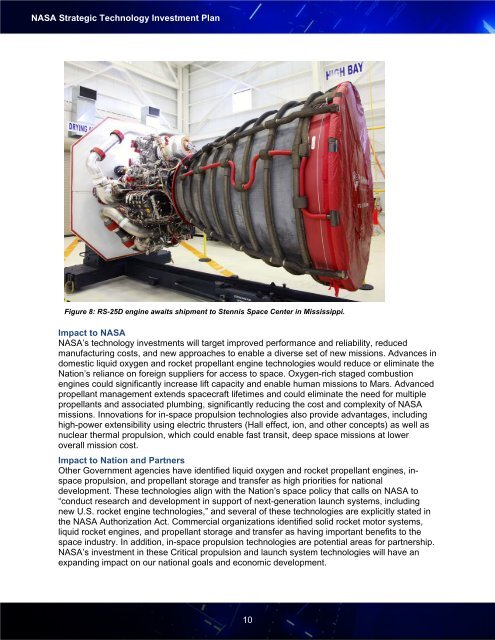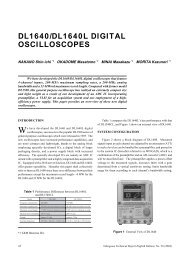2017-8-1_stip_final-508ed
You also want an ePaper? Increase the reach of your titles
YUMPU automatically turns print PDFs into web optimized ePapers that Google loves.
NASA Strategic Technology Investment Plan<br />
Figure 8: RS-25D engine awaits shipment to Stennis Space Center in Mississippi.<br />
Impact to NASA<br />
NASA’s technology investments will target improved performance and reliability, reduced<br />
manufacturing costs, and new approaches to enable a diverse set of new missions. Advances in<br />
domestic liquid oxygen and rocket propellant engine technologies would reduce or eliminate the<br />
Nation’s reliance on foreign suppliers for access to space. Oxygen-rich staged combustion<br />
engines could significantly increase lift capacity and enable human missions to Mars. Advanced<br />
propellant management extends spacecraft lifetimes and could eliminate the need for multiple<br />
propellants and associated plumbing, significantly reducing the cost and complexity of NASA<br />
missions. Innovations for in-space propulsion technologies also provide advantages, including<br />
high-power extensibility using electric thrusters (Hall effect, ion, and other concepts) as well as<br />
nuclear thermal propulsion, which could enable fast transit, deep space missions at lower<br />
overall mission cost.<br />
Impact to Nation and Partners<br />
Other Government agencies have identified liquid oxygen and rocket propellant engines, inspace<br />
propulsion, and propellant storage and transfer as high priorities for national<br />
development. These technologies align with the Nation’s space policy that calls on NASA to<br />
“conduct research and development in support of next-generation launch systems, including<br />
new U.S. rocket engine technologies,” and several of these technologies are explicitly stated in<br />
the NASA Authorization Act. Commercial organizations identified solid rocket motor systems,<br />
liquid rocket engines, and propellant storage and transfer as having important benefits to the<br />
space industry. In addition, in-space propulsion technologies are potential areas for partnership.<br />
NASA’s investment in these Critical propulsion and launch system technologies will have an<br />
expanding impact on our national goals and economic development.<br />
10







